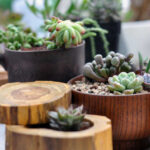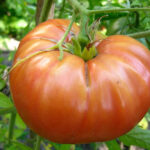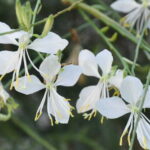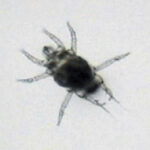Have you ever wondered about growing tarragon – or, for that matter, what it’s used for?
There are several varieties of tarragon (Artemisia dracunculus), but French tarragon is the culinary star and one of the four fines herbes of French fine cooking: parsley, chives, chervil, and tarragon.
Estragon, tarragon in French, has an anise or licorice taste and pairs well with fish, chicken, and egg dishes. It’s often infused with vinegar to easily acidify sauces and pickles, giving them an herbal punch. If you’ve enjoyed béarnaise sauce with your steak, salmon, or asparagus, tarragon is the herb that provides its unique flavor.
Whether you’re cooking your way through Julia Child’s Mastering the Art of French Cooking or rounding out your herb garden, growing tarragon is easy with our how-to guide!
Quick Care Guide

| Common Name(s) | French tarragon, dragon sagewort, estragon, German tarragon |
| Scientific Name | Artemisia dracunculus var. Sativa |
| Days to Harvest | Harvest when there are enough leaves to sustain plant growth, 40-60 days from transplant |
| Light | Full sun to partial shade |
| Water: | Water once or twice a week, let soil dry out between waterings |
| Soil | Dry, aerated, neutral to slightly acidic soil |
| Fertilizer | Compost, composted chicken manure, fish/seaweed emulsion |
| Pests | Spider mites |
| Diseases | Tarragon rust, downy mildew, powdery mildew, Rhizoctonia (root rot) |
All About Tarragon
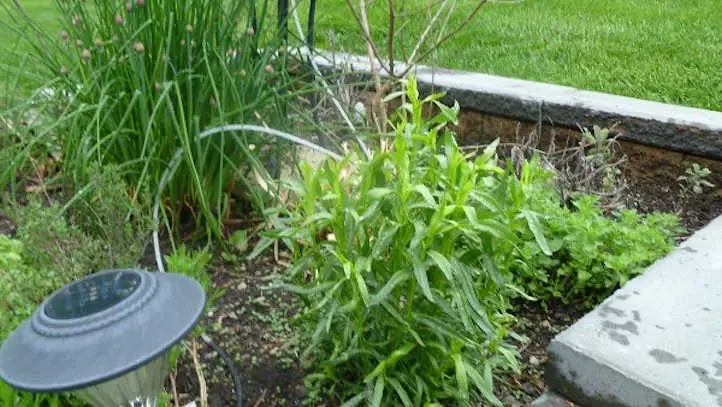
French tarragon (Artemisia dracunculus var. Sativa) is a perennial herb with long, slender, pointy green leaves. Although tarragon is native to southern Russia and western Asia, most dried tarragon that is sold commercially is French tarragon and is grown in France.
French tarragon and Russian tarragon are the two main cultivated tarragon species. They are similar but different, with French tarragon having glossier leaves and a much more pronounced anise aroma and flavor. Russian tarragon (Artemisia dracunculus) also grows much larger, up to 5 feet tall. They are both members of the sunflower and daisy family (Asteraceae).
The French tarragon plant has bushy, branched stems and grows from 18 to 36 inches tall with a horizontal spread of about 12 inches. Although it may produce small yellowish florets, French tarragon does not produce true flowers or tarragon seeds. Instead, it reproduces via its rhizomatous root system or cuttings. If you see tarragon seeds for sale, note that it is likely Russian tarragon.
Planting Tarragon
Although Russian tarragon can be grown from seed, French tarragon herb plants only grow via live transplant. Be aware that plants sold in nurseries could actually be Russian tarragon by mistake. Give a leaf a taste to confirm that it has a pungent anise flavor.
Live plants can be transplanted in the spring or fall, and do best in areas with full sun to part shade. Well-draining soil is essential, so if your garden soil is dense, consider planting a tarragon herb garden in a container or raised bed where you can ensure good drainage.
To transplant live tarragon plants, first water the potted plant. Dig a hole that is twice as wide and about the same depth as the pot. Then, invert the plant, tap on the bottom of the pot to release it – roots, soil, and all – and lower the plant into its new home. Add a couple of inches of compost and then water well. Fill the hole completely with soil and press it gently around the plant. Add a couple inches of organic mulch around the plant to retain moisture and deter weeds. Mature plants will take up about one square foot of space, so plant multiple plants 2 to 3 feet apart.
Care
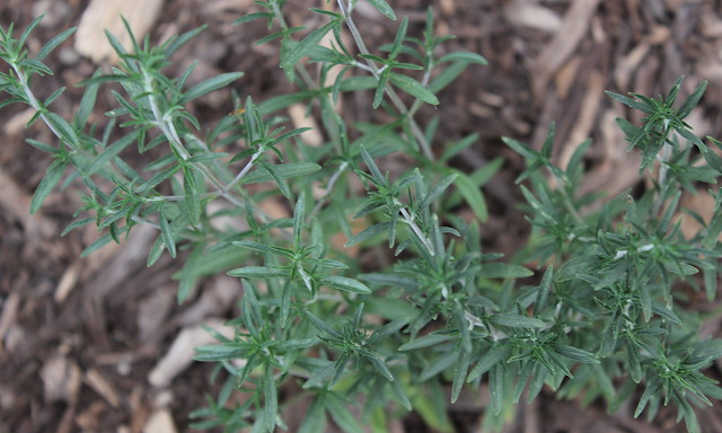
Caring for tarragon can be a breeze as long as you listen to its basic needs and follow some important cultural practices. “Right plant, right place” is a gardening mantra that reminds us that despite our sometimes lofty and idealistic garden dreams, nature runs the show. We can’t expect plants to thrive without providing for their basic needs!
Sun and Temperature
French tarragon requires at least 6 hours of full sun daily. It will tolerate partial shade.
Tarragon herb prefers temperate climates with a winter season that allows a few months of dormancy. However, the plants are also forgiving and grow well from gardening zone 3, with heavy mulching for winter protection, to zone 9. The plants will need protection with shade cloth and more frequent watering if summer temperatures reach 90 degrees Fahrenheit or hotter.
Water and Humidity
To discourage fungal diseases, it’s best to water your tarragon plants in the morning or at the very least with enough time and sunlight for the leaves to dry before sunset. Water the plants at the soil level only to prevent diseases. High humidity can also encourage fungal diseases, so be sure to allow enough space between your plants for good air circulation.
A drip watering system or soaker hose would work well for this herb, but use caution. Tarragon hates “wet legs” and prefers to dry out between waterings, so adjust watering settings as appropriate. Note that tarragon plants in containers will require more frequent watering.
Soil
French tarragon tolerates poor sandy soil but will not do well in compacted clay soil or in soggy conditions. Mildly acidic (pH 6.0 to 7.3), well-draining soil rich with nutrients is best for this herb. Enriching your garden soil with compost will both improve the soil and give your tarragon the rich nutrients it needs to produce its amazing tarragon flavor.
Fertilizing
Tarragon is a pretty easy-going herb and doesn’t require a lot of feeding throughout the season. When planting, include rich compost and top-dress the plants with compost again in the fall.
Your plants will benefit from a seaweed or compost tea foliar spray a few times during the growing season. Or, if you prefer using a pelletized fertilizer, the addition of composted chicken manure every 6 weeks or so will also give your plants a boost.
Pruning
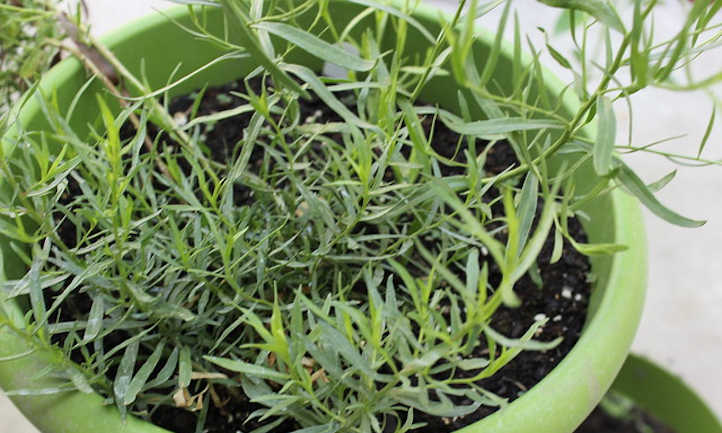
French tarragon does not spread aggressively, so pruning is mainly cosmetic and to encourage new growth.
Once your plant is established and reaches more than 2 feet in height, you may wish to prune it back throughout the growing season to about 2 feet to keep it tidy. Gardeners with multiple plants often prune half of their plants down to 8 inches or so in June or July, which allows enough time for a second harvest about 6 weeks later.
Tarragon leaves will yellow toward the end of the season. That’s your cue to prune the stems down to about 4 inches. If appropriate for your growing area, heavily mulch your plants for overwinter protection. Cut back any browned foliage in early spring to make room for new growth.
Propagation
French tarragon plants don’t propagate by tarragon seeds, but rather through stem cuttings or root system division. In fact, tarragon flower seeds are likely sterile.
To propagate by cuttings, use clean garden shears to cut a 5 to 8 inch stem from just below a node. Remove leaves from the bottom third, dip the stem in rooting hormone, and place it in a pot with potting soil. Keep the soil and plant hydrated until roots form. At that point, transplant to the garden in the spring after your local last frost date.
Some gardeners report better success propagating French tarragon plants through root division in early spring. For this technique, you will need an established French tarragon plant, a garden fork, and a small tool – a knife, for example, that will allow you to separate the plant’s delicate roots. Once you’ve carefully lifted the plant with the garden fork, look for green shoots. Remove 4 to 5 shoots and place them in small pots with potting soil. After hanging out in a shady spot for a couple of weeks, the shoots will have grown root hairs and are now ready for transplanting to the garden.
Harvesting and Storing
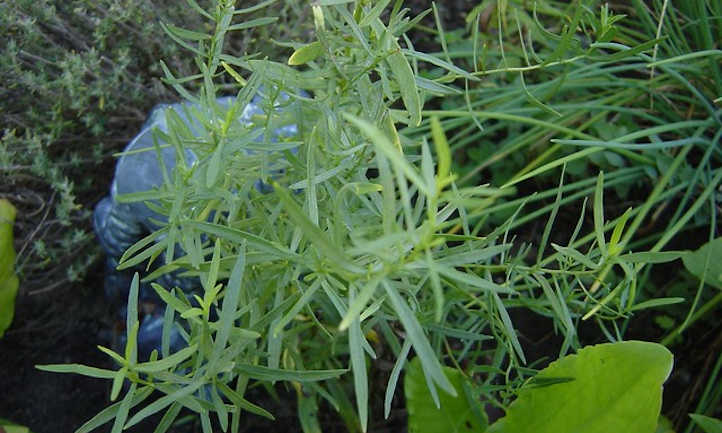
Like many herbs, tarragon is a cut-and-come-again plant that benefits from frequent harvesting. French tarragon’s pungent flavor goes a long way, so if you cut more than you can use right away, try these storage ideas.
Harvesting
Tarragon is ready to be harvested when the plant is established. A general rule is to always leave at least one-third of the leaves intact. To harvest, look for the lighter green new growth and clip the stems carefully with kitchen or pruning shears. Tarragon leaves bruise easily and attempting to snap a woody stem with your fingers could cause damage.
Storing
To store this fresh herb for use within a day or two, place the cut ends of sprigs in a jar with water, cover loosely with a plastic bag, and refrigerate. Similarly, you could wrap the sprigs in damp paper towels and then place in a plastic bag.
For longer storage, there are a few suggested methods. Since the dried herb is widely available, many gardeners think that drying tarragon is the way to go. The argument against drying these leaves is that much of the herb’s wonderful flavor disappears. To maximize flavor when drying, keep leaves whole and store them in airtight containers at room temperature as soon as they’re dry.
Incorporating fresh chopped French tarragon leaves into butter or soaking fresh sprigs in vinegar to make flavored vinegar are two tasty alternatives. Freezing the chopped herb in water in ice cube trays or freezing sprigs in airtight plastic bags are a couple more techniques to try.
Troubleshooting
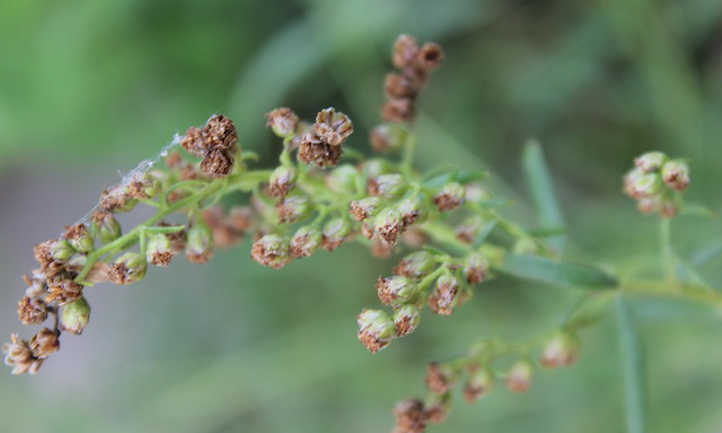
The best way to avoid pests and diseases is to follow a few general rules that promote resilient, healthy plants. Paying attention to sunlight, drainage, nutrient, and water needs and placing plants with correct spacing and air circulation are investments that pay off in health and productivity.
Growing Problems
French tarragon is mostly a no-fuss herb, but growing problems can pop up with extremes – think too hot, too sunny, too cold, too shady, too humid, too wet. Hot weather (90+ degrees Fahrenheit) dries out plants rapidly and scorching sun can burn leaves. Overwintering this herb without adequate protection can frost damage the crown. Not enough sunlight coupled with high humidity or consistently wet conditions can foster fungal diseases and underproduction.
To fight against these challenges, water plants more often during hot weather and protect leaves with shade cloth. Or, consider planting something taller with protective foliage nearby to create natural shade. If you live in an extremely cold growing zone, mulch the plants heavily before temperatures drop. Locate the plants in a suitable area in soil with good drainage, full to part sun, and enough room between plants to support good airflow. Prune overgrown plants consistently to increase air circulation if your climate is humid.
Pests
French tarragon can be a juicy target for spider mites. If you see yellowing spots on the leaves or tiny webs on their undersides, you probably have spider mites. The spots are caused by the mites piercing the plant tissue and sucking out juices. They are ridiculously tiny so don’t rely on your eyes to catch them in the act. You’ll need a magnifying glass for confirmation.
Spraying the plants with water can be effective for knocking off the mites and their larvae, but following up with an application of neem oil or Mite-X will be most effective.
Diseases
French tarragon is susceptible to fungal diseases like tarragon rust, downy mildew, powdery mildew, and rhizoctonia (root rot).
Tarragon rust is a fungus that travels long distances via wind-borne spores. Reddish, rust-like spores appear on the bottoms of leaves after an initial period of white or yellow spots on the leaf tops. Severe cases stunt plant growth and cause leaves to yellow and die. To treat, remove and destroy infected leaves. For prevention, increase air circulation among your tarragon stems and plants and keep leaves dry. Try drip-irrigation or water plants early enough so that the leaves dry completely before sundown.
Downy mildew is caused by microbes that thrive in humid environments. Like tarragon rust, it is also wind-borne and attacks plant leaves. Leaf tops develop white, yellow, or brown spots with accompanying gray mold on leaf bottoms. To treat, remove and destroy infected leaves immediately. Making sure that your planting site has well-draining soil and doesn’t collect standing water will also help keep downy mildew at bay. Neem oil is a good preventive and mild infections may be treated with a copper fungicide.
Powdery mildew is a white, powdery fungus that can attack both the tops and bottoms of leaves. Like the other diseases mentioned, powdery mildew spores travel by wind. The fungus saps plant nutrients causing leaves to brown and die. The good news is that there are many cost-effective and organic treatment options for powdery mildew. Neem oil is our preferred method.
Rhizoctonia root rot is a soil-based fungus that attacks plant roots causing the plants to wither and die. You may see brown or red cankers on plant stems at or just below the soil or leaves that touch infected soil may also become infected and display yellow splotches. To treat, remove diseased plant material immediately. Widespread infection can be treated with commercial natural fungicides that contain mycelium and spores of certain bacterium. Of course, cultural practices like crop rotation, appropriate plant spacing, and good watering practices are essential for rhizoctonia prevention.
Frequently Asked Questions
Q: Is tarragon an annual or perennial?
A: Tarragon is typically a perennial, but it could be either based on your growing zone. Tarragon is winter hardy and appreciates the winter months to regroup before emerging in spring. But if you’re growing in a subtropical climate (zones 8+), plant in the summer or fall and harvest throughout the winter and spring like an annual.
Q: How long does it take to grow tarragon?
A: Typically, it’s best to wait 5 to 6 weeks after transplant to harvest your tarragon. However, if you only need a few leaves to flavor a recipe, harvest when there are enough leaves to sustain plant growth.


